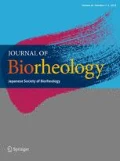Abstract
Recently, a microchannel flow analyzer (MC-FAN) has been used to study the flow properties of blood. However, the correlation between blood passage time measured by use of the MC-FAN and hemorheology has not been clarified. In this study, a simple model is proposed for estimation of liquid viscosity from the passage time t p of liquids. The t p data for physiological saline were well represented by the model. According to the model, the viscosity of Newtonian fluids was estimated reasonably well from the t p data. For blood samples, although the viscosity \( \eta_{\text{mc}} \) estimated from t p was shown to be smaller than the viscosity \( \eta_{{450{\text{s}}^{ - 1} }} \) measured by use of a rotatory viscometer at a shear rate of 450 s−1, \( \eta_{\text{mc}} \) was correlated with \( \eta_{{450{\text{s}}^{ - 1} }} \). An empirical equation for estimation of \( \eta_{{450{\text{s}}^{ - 1} }} \) from \( \eta_{\text{mc}} \) of blood samples is proposed.





References
Tzoulaki I, Murray GD, Lee AJ, Rumley A, Lowe GD, Fowkes GR. Relative value of inflammatory, hemostatic, and rheological factors for incident myocardial infarction and stroke: the Edinburgh Artery Study. Circulation. 2007;115:2119–27.
Lowe GD, Lee AJ, Rumley A, Price JF, Fowkes FG. Blood viscosity and risk of cardiovascular events: the Edinburgh Artery Study. Br J Haematol. 1997;96:168–73.
Koenig W, Sund M, Filipiak B, Doering A, Loewel H, Ernst E. Plasma viscosity and the risk of coronary heart disease: results from the MONICA-Augsburg cohort study, 1984 to 1992. Arterioscler Thromb Vasc Biol. 1998;18:768–72.
Seki K, Sumino H, Nara M, Ishiyama N, Nishino M, Murakami M. Relationships between blood rheology and age, body mass index, blood cell count, fibrinogen, and lipids in healthy subjects. Clin Hemorheol Microcirc. 2006;34:401–10.
Sumino H, Nara M, Seki K, Takahashi T, Kanda T, Ichikawa S, Goto-Onozato K, Koya S, Murakami M, Kurabayashi M. Effect of antihypertensive therapy on blood rheology in patients with essential hypertension. J Int Med Res. 2005;33:170–7.
Muranaka Y, Kunimoto F, Takita J, Sumino H, Nara M, Kuwano H, Murakami M. Impaired blood rheology in critically ill patients in intensive care unit. J Int Med Res. 2006;34:419–27.
Nara M, Sumino H, Nara M, Machida T, Amagai H, Nakajima K, Murakami M. Impaired blood rheology and elevated remnant-like lipoprotein particle cholesterol in hypercholesterolaemic subjects. J Int Med Res. 2009;37:308–17.
Machida T, Sumino H, Fukushima M, Kotajima N, Amagai H, Murakami M. Blood rheology and low-density lipoprotein cholesterol/high-density lipoprotein cholesterol ratio in dyslipidemic and normolipidemic subjects. J Int Med Res. 2010;38:1975–84.
Kurihara T, Deguchi S, Kato J, Furakawa M, Tsuchiya M, Akimoto M, Ishiguro H, Hashimoto H, Niimi A, Maeda A, Shigemoto M, Yamashita K, Kawakami A, Umemura K, Nakashima M, Nakano T, Saniabadi AR. Impaired blood rheology by remnant-like lipoprotein particles: studies in patients with fatty liver disease. Clin Hemorheol Microcirc. 2001;24:217–25.
Lee CYJ, Kim KC, Park HW, et al. Rheological properties of erythrocytes from male hypercholesterolemia. Microvasc Res. 2004;67:133–8.
Kikuchi Y, Sato K, Ohki H, Kaneko T. Optically accessible microchannels formed in a single-crystal silicon substrate for studies of blood rheology. Microvasc Res. 1992;44:226–40.
Kikuchi Y, Sato K, Mizuguchi Y. Modified cell-flow microchannels in a single-crystal silicon substrate and flow behavior of blood cells. Microvasc Res. 1994;47:126–39.
Bevington PR. Data reduction and error analysis for the physical sciences. New York: McGraw-Hill; 1969.
Shin S, Park MS, Ku Y, Jang JH, Suh JS. Simultaneous measurement of red blood cell aggregation and viscosity: light transmission slit rheometer. J Mech Sci Tech. 2005;19:209–15.
Chien S, Usami S, Skalak R. Blood flow in small tubes. In: Renkin EM, Michel CC, editors. Handbook of Physiology, Section 2: The Cardiovascular system, Vol. IV. Microcirculation. Bethesda: American Physiological Society; 1984.
Pries AR, Neuhaus D, Gaehtgens P. Blood viscosity in tube flow: dependence on diameter and hematocrit. Am J Physiol. 1992;263:H1771–8.
Author information
Authors and Affiliations
Corresponding author
About this article
Cite this article
Maki, Y., Endo, Y., Fukushima, M. et al. Estimation of viscosity from passage time of liquids flowing through a microchannel array. J Biorheol 26, 69–73 (2013). https://doi.org/10.1007/s12573-012-0048-5
Received:
Accepted:
Published:
Issue Date:
DOI: https://doi.org/10.1007/s12573-012-0048-5

